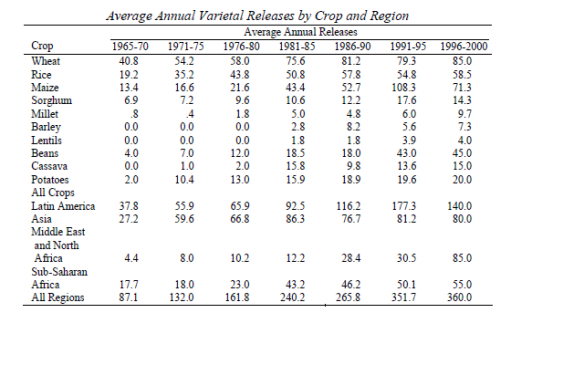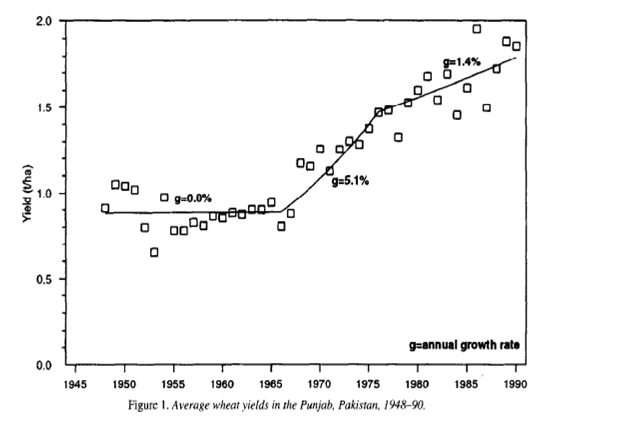The Green Revolution had effects and consequences spanning
the entire globe. With an increase in agricultural trade of about 4.3% a
year between the years of 1960-1980 the Green Revolution allowed for an
increase in agricultural production in any country that employed it
(Kaul 386). The ability to produce crops at any time of the year in an
increased capacity far exceeding previous farming techniques was seen as
an innovation of the ages. Yet the results of the Green Revolution were
always promising at the start, as years went on they rarely lived up to
the hopes. This is the case for the Green Revolution in Pakistan; it
started out promising with high yields of production and a boom to the
economy that may actually have been worth the risk, but as time went on
the Pakistan government was unable to sustain this output. In this essay
will be discussed the start of the Green Revolution in Pakistan, its
initial effects, the following decline of productivity, and the overall
effects it had on the economy.
The above chart shows the average output of crops for
countries during the Green Revolution era. It can be seen from 1965-1980
the production of crops doubles and then the average increases slowly
from then on.
The increase in agricultural productivity made the production of more
crops a priority to the Pakistan government; as more crops meant more
money. Wheat in particular was very profitable from 1967 to 1970
(Mohammad 495). The production of wheat nearly doubled from 1960 to 1970
as can be seen in the chart below.
The government funded several developmental programs to
make the production of crops easier for the farmers. This included the
creation of surface and ground water aquifers which allowed for better
irrigation systems in rural areas, the promotion of fertilizer and HYV
(High Yielding Varieties of crops) use, and the introduction of tractors
to facilitate the increased production of crops (Chaudry 173). The
government also made policy changes which allowed small scale
agricultural industries to thrive (Child 275). Thus the Pakistan
government nurtured its new source of income, trying to construct a
profitable agricultural system that would last. Unfortunately for
Pakistan the Green Revolution would fail in their country as it did in
so many others.
Why the Green
Revolution failed in Pakistan can be attributed to many reasons. The
first would be resource degradation, which is the decrease in fertility
of the land producing a lower yield in crops. Below is a chart showing
the annual production of wheat in Pakistan. It can be seen as the Green
Revolution starts the annual growth rate is 5.1 percent yet by the year
1976 the rate drops to 1.4 percent. This was caused by several factors
including resource degradation.
Due to poor farming techniques the farmers of Pakistan
overused the land thus rendering it less fertile and unable to yield
large amounts of crops. Overall the decrease in productivity was about a
third compared to the initial production rates (Murgai 214). Resource
degradation was not a problem for just Pakistan, many countries in South
Asia and the Middle East had similar problems when they started using
the Green Revolution techniques. This problem however was not easily
solved; to fix it would require the introduction of new farming
techniques and the creation of better irrigation systems to keep the
land fertile. Neither of these Pakistan was able to accomplish and thus
resource degradation was a major contributor to the decline of the crop
yield in Pakistan (Murgai 208).
Another reason for the decline of the Green Revolution in
Pakistan was due to the fact that Pakistan was unable to use genetically
engineered crops. In the 1980’s when genetically engineered crops were
being used by other Southern Asian countries Pakistan was using hardier
forms of crops but not the genetically modified versions that produced
even higher yields. This is because Pakistan was not able to create the
regulatory systems necessary to monitor the usage of genetically
modified crops along with the fact they were unable to create them. The
obvious reasons for why this had a negative effect is that these crops
produced higher yields, but another impact of the inability to use
genetically modified crops was that neighboring countries did not have
the same restrictions. In fact most of the other countries in South
Asia used genetically modified crops and were thus able to produce and
sell more, lowering the cost of these crops on the international market.
The lower price of crops affected Pakistan greatly because they were
not able to produce at the same rate as their neighbors. Thus the
inability to use genetically modified crops contributed to the decline
of the Green Revolution in Pakistan (Evenson 3).
The final reason for the decline of the Green Revolution
was the policies (or lack of policies) implemented by the Pakistan
government. As stated before poor irrigation and bad farming techniques
led to resource degradation in Pakistan. The Pakistan government could
have easily implemented policies to prevent this outcome yet they failed
to do so. Another fault was the inability of the government to
introduce genetically modified crops that would allow for a greater
yield. The creation of regulatory policies to oversee the usage of
genetically modified crops could have increased production of crops
greatly allowing Pakistan to compete with its neighboring countries on
the international market. The final failing of the government was the
lack of investment in infrastructure. In India the creation and
advancement of their infrastructure allowed the facilitation of
agricultural and economic growth. If Pakistan had followed this example
and expanded their infrastructure then perhaps they would have seen a
similar increase in the growth of their agricultural production (Murgai
214).
The decline of the Green Revolution in Pakistan is not
unique. In fact many third world countries were unable to successfully
maintain initial production rates due to similar problems that Pakistan
experienced, these problems relating to poor irrigation, bad farming
techniques, and the lack of government policies to facilitate growth.
Most of these nations had hoped that the Green revolution would be the
key to creating a constant flow of money into their economies as well as
increasing the production of crops each year. Looking back now it is
obvious that most countries did not obtain this agricultural
productivity. Though the agricultural productivity did not last as long
as hoped, the Green Revolution had positive effects in Pakistan that
involved the economy and its increase in size, a response to the
increase of agricultural growth. It can be said that perhaps the
positive effect the Green Revolution had on the Pakistan economy was
just as impressive as the impact it had on the production of wheat.
From the chart it can be seen that due to the Green
Revolution the income to the agricultural sector doubled. It is thus
proven with this data that the income of Pakistan as a whole was
increased due to the Green Revolution, whether or not that income was
distributed evenly is another matter.
There has been dispute on whether or not the increase in income
distribution was seen equally throughout all income levels or whether
only the rich landowners prospered from the Green Revolution. Based on
the information about income levels at the time it is more plausible
that all levels of society prospered from the growth in agriculture not
just the rich. As seen from the chart below which compares the increase
of small landowning farmers compared to larger farmers it can be seen
that the Green revolution increased the small farmer’s income more than
it did the large farmer (by percentage).Below is another chart that shows the relative income increase between a landlord and those who work on his land. It can be seen that over the course of the Green Revolution the rate at which income increased was greater for people who were considered to be lower class workers such as peasants or tenants.
From the above two charts the result can be determined that
the Green Revolution was not just profitable for the wealthy by making
them wealthier, its impact was spread to the lower class, to the people
who worked on the farms harvesting the crops. In fact based off these
results the Green Revolution helped close the income gap problem in
Pakistan.
From these facts listed it can be said that the Green
Revolution provided a short burst of large scale production of various
forms of crops. Along with this increase in crop yield and agriculture
there was also an increase to the economy especially to peasant farmers
who acquired larger incomes from the increased production of crops. Even
after the Green Revolution started to falter in the mid 1970’s the
effect it had on the economy lasted beyond that. The increase in per
capita did not decline along with the Green Revolution decline and the
income gap which was lessened during the agricultural boom was also not
widened when it lulled. Thus I argue that the positive effects the Green
Revolution had on the Pakistan economy were not negated and in fact the
effects on the economy have prevailed long after the fire that spawned
them puttered out. Finally, the Green Revolution overall had a positive
impact on Pakistan even though the movement failed agriculturally, the
economic aspect more then made up for this.





